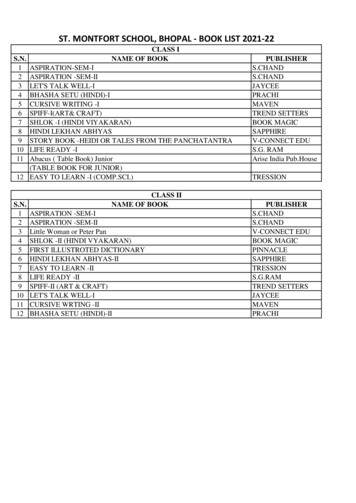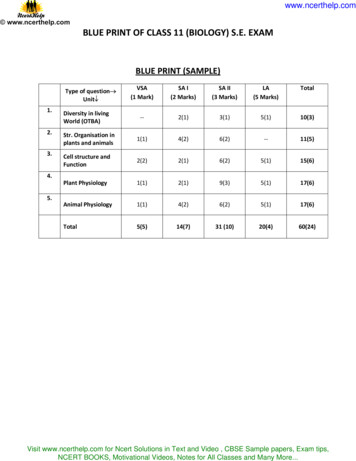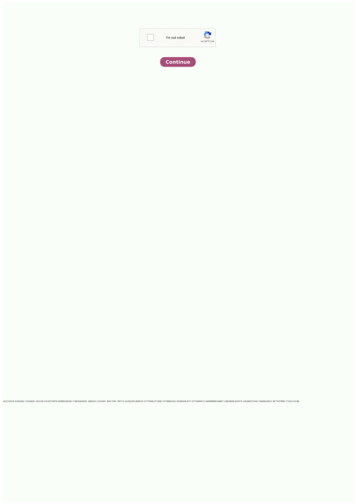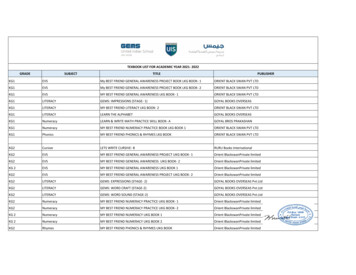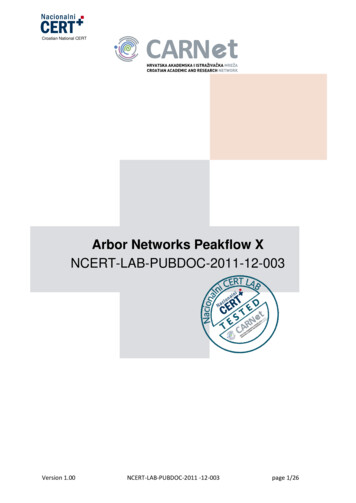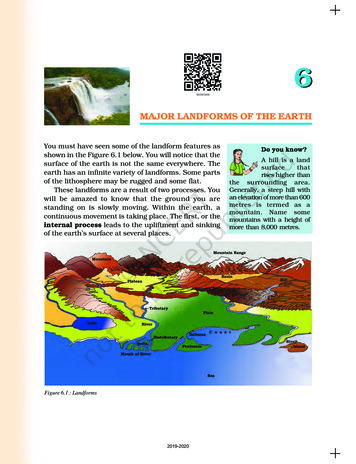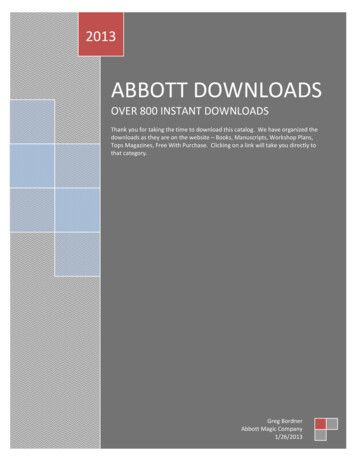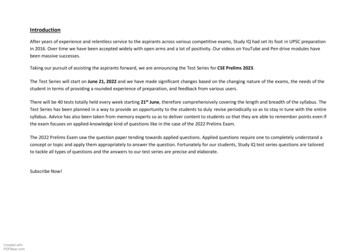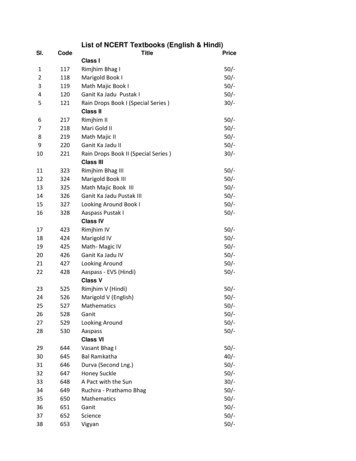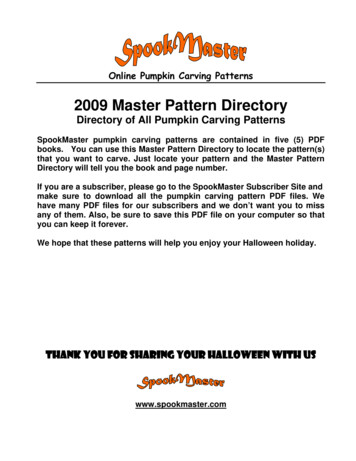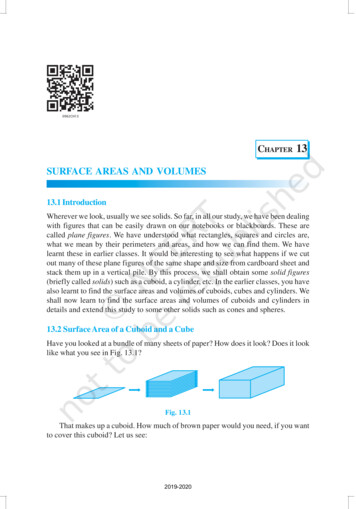
Transcription
208MATHEMATICSCHAPTER 13SURFACE AREAS AND VOLUMES13.1 IntroductionWherever we look, usually we see solids. So far, in all our study, we have been dealingwith figures that can be easily drawn on our notebooks or blackboards. These arecalled plane figures. We have understood what rectangles, squares and circles are,what we mean by their perimeters and areas, and how we can find them. We havelearnt these in earlier classes. It would be interesting to see what happens if we cutout many of these plane figures of the same shape and size from cardboard sheet andstack them up in a vertical pile. By this process, we shall obtain some solid figures(briefly called solids) such as a cuboid, a cylinder, etc. In the earlier classes, you havealso learnt to find the surface areas and volumes of cuboids, cubes and cylinders. Weshall now learn to find the surface areas and volumes of cuboids and cylinders indetails and extend this study to some other solids such as cones and spheres.13.2 Surface Area of a Cuboid and a CubeHave you looked at a bundle of many sheets of paper? How does it look? Does it looklike what you see in Fig. 13.1?Fig. 13.1That makes up a cuboid. How much of brown paper would you need, if you wantto cover this cuboid? Let us see:2019-2020
SURFACE AREAS AND VOLUMES209First we would need a rectangular piece to coverthe bottom of the bundle. That would be as shown inFig. 13.2 (a)Then we would need two long rectangular piecesto cover the two side ends. Now, it would look likeFig. 13.2 (b).Now to cover the front and back ends, we wouldneed two more rectangular pieces of a different size.With them, we would now have a figure as shown inFig. 13.2(c).This figure, when opened out, would look likeFig. 13.2 (d).Finally, to cover the top of the bundle, we wouldrequire another rectangular piece exactly like the oneat the bottom, which if we attach on the right side, itwould look like Fig. 13.2(e).So we have used six rectangular pieces to coverthe complete outer surface of the cuboid.Fig. 13.22019-2020
210MATHEMATICSThis shows us that the outer surface of a cuboid is made up of six rectangles (infact, rectangular regions, called the faces of the cuboid), whose areas can be found bymultiplying length by breadth for each of them separately and then adding the sixareas together.Now, if we take the length of the cuboid as l, breadth as b and the height as h, thenthe figure with these dimensions would be like the shape you see in Fig. 13.2(f).So, the sum of the areas of the six rectangles is:Area of rectangle 1 ( l h) Area of rectangle 2 ( l b) Area of rectangle 3 ( l h) Area of rectangle 4 ( l b) Area of rectangle 5 ( b h) Area of rectangle 6 ( b h) 2(l b) 2(b h) 2(l h) 2(lb bh hl)This gives us:Surface Area of a Cuboid 2(lb bh hl)where l, b and h are respectively the three edges of the cuboid.Note : The unit of area is taken as the square unit, because we measure the magnitudeof a region by filling it with squares of side of unit length.For example, if we have a cuboid whose length, breadth and height are 15 cm,10 cm and 20 cm respectively, then its surface area would be:2[(15 10) (10 20) (20 15)] cm2 2(150 200 300) cm2 2 650 cm2 1300 cm22019-2020
SURFACE AREAS AND VOLUMES211Recall that a cuboid, whose length, breadth and height are all equal, is called acube. If each edge of the cube is a, then the surface area of this cube would be2(a a a a a a), i.e., 6a2 (see Fig. 13.3), giving usSurface Area of a Cube 6a 2where a is the edge of the cube.Fig. 13.3Suppose, out of the six faces of a cuboid, we only find the area of the four faces,leaving the bottom and top faces. In such a case, the area of these four faces is calledthe lateral surface area of the cuboid. So, lateral surface area of a cuboid oflength l, breadth b and height h is equal to 2lh 2bh or 2(l b)h. Similarly,lateral surface area of a cube of side a is equal to 4a2.Keeping in view of the above, the surface area of a cuboid (or a cube) is sometimesalso referred to as the total surface area. Let us now solve some examples.Example 1 : Mary wants to decorate her Christmastree. She wants to place the tree on a wooden boxcovered with coloured paper with picture of SantaClaus on it (see Fig. 13.4). She must know the exactquantity of paper to buy for this purpose. If the boxhas length, breadth and height as 80 cm, 40 cm and20 cm respectively how many square sheets of paperof side 40 cm would she require?Solution : Since Mary wants to paste the paper onthe outer surface of the box; the quantity of paperrequired would be equal to the surface area of thebox which is of the shape of a cuboid. The dimensionsof the box are:2019-2020Fig. 13.4
212MATHEMATICSLength 80 cm, Breadth 40 cm, Height 20 cm.The surface area of the box 2(lb bh hl) 2[(80 40) (40 20) (20 80)] cm2 2[3200 800 1600] cm2 2 5600 cm2 11200 cm2The area of each sheet of the paper 40 40 cm2 1600 cm2Therefore, number of sheets required surface area of boxarea of one sheet of paper11200 71600So, she would require 7 sheets.Example 2 : Hameed has built a cubical water tank with lid for his house, with eachouter edge 1.5 m long. He gets the outer surface of the tank excluding the base,covered with square tiles of side 25 cm (see Fig. 13.5). Find how much he wouldspend for the tiles, if the cost of the tiles is 360 per dozen.Solution : Since Hameed is getting the five outer faces of the tank covered with tiles,he would need to know the surface area of the tank, to decide on the number of tilesrequired.Edge of the cubical tank 1.5 m 150 cm ( a)So,surface area of the tank 5 150 150 cm2Area of each square tile side side 25 25 cm2So, the number of tiles required surface area of the tankarea of each tile5 150 150 18025 25Cost of 1 dozen tiles, i.e., cost of 12 tiles 360Therefore, cost of one tile 360 3012So, the cost of 180 tiles 180 30 54002019-2020Fig. 13.5
SURFACE AREAS AND VOLUMES213EXERCISE 13.11.A plastic box 1.5 m long, 1.25 m wide and 65 cm deep is to be made. It is opened at thetop. Ignoring the thickness of the plastic sheet, determine:(i) The area of the sheet required for making the box.(ii) The cost of sheet for it, if a sheet measuring 1m2 costs 20.2.The length, breadth and height of a room are 5 m, 4 m and 3 m respectively. Find thecost of white washing the walls of the room and the ceiling at the rate of 7.50 per m2.3.The floor of a rectangular hall has a perimeter 250 m. If the cost of painting the fourwalls at the rate of 10 per m2 is 15000, find the height of the hall.[Hint : Area of the four walls Lateral surface area.]4.The paint in a certain container is sufficient to paint an area equal to 9.375 m2. Howmany bricks of dimensions 22.5 cm 10 cm 7.5 cm can be painted out of thiscontainer?5.A cubical box has each edge 10 cm and another cuboidal box is 12.5 cm long, 10 cmwide and 8 cm high.(i) Which box has the greater lateral surface area and by how much?(ii) Which box has the smaller total surface area and by how much?6.A small indoor greenhouse (herbarium) is made entirely of glass panes (includingbase) held together with tape. It is 30 cm long, 25 cm wide and 25 cm high.(i) What is the area of the glass?(ii) How much of tape is needed for all the 12 edges?7.Shanti Sweets Stall was placing an order for making cardboard boxes for packingtheir sweets. Two sizes of boxes were required. The bigger of dimensions25 cm 20 cm 5 cm and the smaller of dimensions 15 cm 12 cm 5 cm. For all theoverlaps, 5% of the total surface area is required extra. If the cost of the cardboard is 4 for 1000 cm2, find the cost of cardboard required for supplying 250 boxes of eachkind.8.Parveen wanted to make a temporary shelter for her car, by making a box-like structurewith tarpaulin that covers all the four sides and the top of the car (with the front faceas a flap which can be rolled up). Assuming that the stitching margins are very small,and therefore negligible, how much tarpaulin would be required to make the shelter ofheight 2.5 m, with base dimensions 4 m 3 m?2019-2020
214MATHEMATICS13.3 Surface Area of a Right Circular CylinderIf we take a number of circular sheets of paper and stack them up as we stacked uprectangular sheets earlier, what would we get (see Fig. 13.6)?Fig. 13.6Here, if the stack is kept vertically up, we get what is called a right circularcylinder, since it has been kept at right angles to the base, and the base is circular. Letus see what kind of cylinder is not a right circular cylinder.In Fig 13.7 (a), you see a cylinder, whichis certainly circular, but it is not at right anglesto the base. So, we can not say this a rightcircular cylinder.Of course, if we have a cylinder with anon circular base, as you see in Fig. 13.7 (b),then we also cannot call it a right circularcylinder.Fig. 13.7Remark : Here, we will be dealing with only right circular cylinders. So, unless statedotherwise, the word cylinder would mean a right circular cylinder.Now, if a cylinder is to be covered with coloured paper, how will we do it with theminimum amount of paper? First take a rectangular sheet of paper, whose length isjust enough to go round the cylinder and whose breadth is equal to the height of thecylinder as shown in Fig. 13.8.2019-2020
SURFACE AREAS AND VOLUMES215lFig. 13.8The area of the sheet gives us the curved surface area of the cylinder. Note thatthe length of the sheet is equal to the circumference of the circular base which is equalto 2πr.So, curved surface area of the cylinder area of the rectangular sheet length breadth perimeter of the base of the cylinder h 2πr hπ rhTherefore, Curved Surface Area of a Cylinder 2πwhere r is the radius of the base of the cylinder and h is the height of the cylinder.Remark : In the case of a cylinder, unless statedotherwise, ‘radius of a cylinder’ shall mean’ base radiusof the cylinder’.If the top and the bottom of the cylinder are also tobe covered, then we need two circles (infact, circularregions) to do that, each of radius r, and thus having anarea of πr2 each (see Fig. 13.9), giving us the totalsurface area as 2πrh 2πr2 2πr(r h).So,Total Surface Area of a Cylinder 2ππ r(r h)where h is the height of the cylinder and r its radius.Fig. 13.9Remark : You may recall from Chapter 1 that π is an irrational number. So, the value2019-2020
216MATHEMATICSof π is a non-terminating, non-repeating decimal. But when we use its value in our22or 3.14.calculations, we usually take its value as approximately equal to7Example 3 : Savitri had to make a model of a cylindrical kaleidoscope for her scienceproject. She wanted to use chart paper to make the curved surface of the kaleidoscope.(see Fig 13.10). What would be the area of chart paper required by her, if she wantedto make a kaleidoscope of length 25 cm with a 3.5 cm radius? You may take π 22.7Solution : Radius of the base of the cylindrical kaleidoscope (r) 3.5 cm.Height (length) of kaleidoscope (h) 25 cm.Area of chart paper required curved surface area of the kaleidoscope 2πrh22 3.5 25 cm27 550 cm2 2 Fig. 13.10EXERCISE 13.2Assume π 22, unless stated otherwise.71.The curved surface area of a right circular cylinder of height 14 cm is 88 cm2. Find thediameter of the base of the cylinder.2.It is required to make a closed cylindrical tank of height 1 m and base diameter 140 cmfrom a metal sheet. How many square metres of the sheet are required for the same?3.A metal pipe is 77 cm long. The inner diameter of a crosssection is 4 cm, the outer diameter being 4.4 cm(see Fig. 13.11). Find its(i) inner curved surface area,(ii) outer curved surface area,(iii) total surface area.Fig. 13.112019-2020
SURFACE AREAS AND VOLUMES2174.The diameter of a roller is 84 cm and its length is 120 cm. It takes 500 completerevolutions to move once over to level a playground. Find the area of the playgroundin m2.5.A cylindrical pillar is 50 cm in diameter and 3.5 m in height. Find the cost of paintingthe curved surface of the pillar at the rate of 12.50 per m2.6.Curved surface area of a right circular cylinder is 4.4 m2. If the radius of the base of thecylinder is 0.7 m, find its height.7.The inner diameter of a circular well is 3.5 m. It is 10 m deep. Find(i) its inner curved surface area,(ii) the cost of plastering this curved surface at the rate of 40 per m2.8.In a hot water heating system, there is a cylindrical pipe of length 28 m and diameter5 cm. Find the total radiating surface in the system.9.Find(i) the lateral or curved surface area of a closed cylindrical petrol storage tank that is4.2 m in diameter and 4.5 m high.1(ii) how much steel was actually used, ifof the steel actually used was wasted in12making the tank.10. In Fig. 13.12, you see the frame of a lampshade. It is to becovered with a decorative cloth. The frame has a basediameter of 20 cm and height of 30 cm. A margin of 2.5 cmis to be given for folding it over the top and bottom of theframe. Find how much cloth is required for covering thelampshade.Fig. 13.1211. The students of a Vidyalaya were asked to participate in a competition for making anddecorating penholders in the shape of a cylinder with a base, using cardboard. Eachpenholder was to be of radius 3 cm and height 10.5 cm. The Vidyalaya was to supplythe competitors with cardboard. If there were 35 competitors, how much cardboardwas required to be bought for the competition?13.4 Surface Area of a Right Circular ConeSo far, we have been generating solids by stacking up congruent figures. Incidentally,such figures are called prisms. Now let us look at another kind of solid which is not aprism (These kinds of solids are called pyramids.). Let us see how we can generatethem.Activity : Cut out a right-angled triangle ABC right angled at B. Paste a long thickstring along one of the perpendicular sides say AB of the triangle [see Fig. 13.13(a)].Hold the string with your hands on either sides of the triangle and rotate the triangle2019-2020
218MATHEMATICSabout the string a number of times. What happens? Do you recognize the shape thatthe triangle is forming as it rotates around the string [see Fig. 13.13(b)]? Does itremind you of the time you had eaten an ice-cream heaped into a container of thatshape [see Fig. 13.13 (c) and (d)]?Fig. 13.13This is called a right circular cone. In Fig. 13.13(c)of the right circular cone, the point A is called thevertex, AB is called the height, BC is called the radiusand AC is called the slant height of the cone. Here Bwill be the centre of circular base of the cone. Theheight, radius and slant height of the cone are usuallydenoted by h, r and l respectively. Once again, let ussee what kind of cone we can not call a right circularcone. Here, you are (see Fig. 13.14)! What you seein these figures are not right circular cones; becausein (a), the line joining its vertex to the centre of itsbase is not at right angle to the base, and in (b) thebase is not circular.Fig. 13.14As in the case of cylinder, since we will be studying only about right circular cones,remember that by ‘cone’ in this chapter, we shall mean a ‘right circular cone.’Activity : (i) Cut out a neatly made paper cone that does not have any overlappedpaper, straight along its side, and opening it out, to see the shape of paper that formsthe surface of the cone. (The line along which you cut the cone is the slant height ofthe cone which is represented by l). It looks like a part of a round cake.2019-2020
SURFACE AREAS AND VOLUMES219(ii) If you now bring the sides marked A and B at the tips together, you can see thatthe curved portion of Fig. 13.15 (c) will form the circular base of the cone.Fig. 13.15(iii) If the paper like the one in Fig. 13.15 (c) is now cut into hundreds of little pieces,along the lines drawn from the point O, each cut portion is almost a small triangle,whose height is the slant height l of the cone.(iv) Now the area of each triangle 12 base of each triangle l.So, area of the entire piece of paper sum of the areas of all the triangles1111b1l b2l b3l l ( b1 b2 b3 )22221 l length of entire curved boundary of Fig. 13.15(c)2(as b1 b2 b3 . . . makes up the curved portion of the figure) But the curved portion of the figure makes up the perimeter of the base of the coneand the circumference of the base of the cone 2πr, where r is the base radius of thecone.So, Curved Surface Area of a Cone 1π r π rl l 2π2where r is its base radius and l its slant height.Note that l2 r2 h2 (as can be seen from Fig. 13.16), byapplying Pythagoras Theorem. Here h is the height of thecone.Fig. 13.162019-2020
220MATHEMATICSTherefore, l r 2 h2Now if the base of the cone is to be closed, then a circular piece of paper of radius ris also required whose area is πr2.So, Total Surface Area of a Cone π rl π r2 π r(l r)Example 4 : Find the curved surface area of a right circular cone whose slant heightis 10 cm and base radius is 7 cm.Solution : Curved surface area πrl22 7 10 cm27 220 cm2 Example 5 : The height of a cone is 16 cm and its base radius is 12 cm. Find thecurved surface area and the total surface area of the cone (Use π 3.14).Solution : Here, h 16 cm and r 12 cm.So, from l2 h2 r2, we havel 162 122 cm 20 cmSo, curved surface area πrl 3.14 12 20 cm2 753.6 cm2Further, total surface area πrl πr2 (753.6 3.14 12 12) cm2 (753.6 452.16) cm2 1205.76 cm2Example 6 : A corn cob (see Fig. 13.17), shaped somewhatlike a cone, has the radius of its broadest end as 2.1 cm andlength (height) as 20 cm. If each 1 cm2 of the surface of thecob carries an average of four grains, find how many grainsyou would find on the entire cob.Fig. 13.17Solution : Since the grains of corn are found only on the curved surface of the corncob, we would need to know the curved surface area of the corn cob to find the totalnumber of grains on it. In this question, we are given the height of the cone, so weneed to find its slant height.2019-2020
SURFACE AREAS AND VOLUMESHere,l r 2 h2 221(2.1)2 202 cm 404.41 cm 20.11 cmTherefore, the curved surface area of the corn cob πrl22 2.1 20.11 cm2 132.726 cm2 132.73 cm2 (approx.)7Number of grains of corn on 1 cm2 of the surface of the corn cob 4 Therefore, number of grains on the entire curved surface of the cob 132.73 4 530.92 531 (approx.)So, there would be approximately 531 grains of corn on the cob.EXERCISE 13.322, unless stated otherwise.7Diameter of the base of a cone is 10.5 cm and its slant height is 10 cm. Find its curvedsurface area.Assume π 1.2.Find the total surface area of a cone, if its slant height is 21 m and diameter of its baseis 24 m.3.Curved surface area of a cone is 308 cm2 and its slant height is 14 cm. Find(i) radius of the base and (ii) total surface area of the cone.4.A conical tent is 10 m high and the radius of its base is 24 m. Find(i) slant height of the tent.(ii) cost of the canvas required to make the tent, if the cost of 1 m2 canvas is 70.5.What length of tarpaulin 3 m wide will be required to make conical tent of height 8 mand base radius 6 m? Assume that the extra length of material that will be required forstitching margins and wastage in cutting is approximately 20 cm (Use π 3.14).6.The slant height and base diameter of a conical tomb are 25 m and 14 m respectively.Find the cost of white-washing its curved surface at the rate of 210 per 100 m2.7.A joker’s cap is in the form of a right circular cone of base radius 7 cm and height24 cm. Find the area of the sheet required to make 10 such caps.8.A bus stop is barricaded from the remaining part of the road, by using 50 hollowcones made of recycled cardboard. Each cone has a base diameter of 40 cm and height1 m. If the outer side of each of the cones is to be painted and the cost of painting is 12 per m2, what will be the cost of painting all these cones? (Use π 3.14 and take1.04 1.02)2019-2020
222MATHEMATICS13.5 Surface Area of a SphereWhat is a sphere? Is it the same as a circle? Can you draw a circle on a paper? Yes,you can, because a circle is a plane closed figure whose every point lies at a constantdistance (called radius) from a fixed point, which is called the centre of the circle.Now if you paste a string along a diameter of a circular disc and rotate it as you hadrotated the triangle in the previous section, you see a new solid (see Fig 13.18). Whatdoes it resemble? A ball? Yes. It is called a sphere.Fig. 13.18Can you guess what happens to the centre of the circle, when it forms a sphere onrotation? Of course, it becomes the centre of the sphere. So, a sphere is a threedimensional figure (solid figure), which is made up of all points in the space,which lie at a constant distance called the radius, from a fixed point called thecentre of the sphere.Note : A sphere is like the surface of a ball. The word solid sphere is used for thesolid whose surface is a sphere.Activity : Have you ever played with a top or have you at least watched someoneplay with one? You must be aware of how a string is wound around it. Now, let us takea rubber ball and drive a nail into it. Taking support of the nail, let us wind a stringaround the ball. When you have reached the ‘fullest’ part of the ball, use pins to keepthe string in place, and continue to wind the string around the remaining part of the ball,till you have completely covered the ball [see Fig. 13.19(a)]. Mark the starting andfinishing points on the string, and slowly unwind the string from the surface of the ball.Now, ask your teacher to help you in measuring the diameter of the ball, from whichyou easily get its radius. Then on a sheet of paper, draw four circles with radius equal2019-2020
SURFACE AREAS AND VOLUMES223to the radius of the ball. Start filling the circles one by one, with the string you hadwound around the ball [see Fig. 13.19(b)].Fig. 13.19What have you achieved in all this?The string, which had completely covered the surface area of the sphere, has beenused to completely fill the regions of four circles, all of the same radius as of the sphere.So, what does that mean? This suggests that the surface area of a sphere of radius r 4 times the area of a circle of radius r 4 (π r2)So,Surface Area of a Sphere 4 π r2where r is the radius of the sphere.How many faces do you see in the surface of a sphere? There is only one, which iscurved.Now, let us take a solid sphere, and slice it exactly ‘throughthe middle’ with a plane that passes through its centre. Whathappens to the sphere?Yes, it gets divided into two equal parts (see Fig. 13.20)!What will each half be called? It is called a hemisphere.(Because ‘hemi’ also means ‘half’)Fig. 13.20And what about the surface of a hemisphere? How many faces does it have?Two! There is a curved face and a flat face (base).The curved surface area of a hemisphere is half the surface area of the sphere, which1isof 4πr2.22019-2020
224Therefore,MATHEMATICSCurved Surface Area of a Hemisphere 2ππ r2where r is the radius of the sphere of which the hemisphere is a part.Now taking the two faces of a hemisphere, its surface area 2πr2 πr2So, Total Surface Area of a Hemisphere 3ππ r2Example 7 : Find the surface area of a sphere of radius 7 cm.Solution : The surface area of a sphere of radius 7 cm would be224πr2 4 7 7 cm2 616 cm27Example 8 : Find (i) the curved surface area and (ii) the total surface area of ahemisphere of radius 21 cm.Solution : The curved surface area of a hemisphere of radius 21 cm would be22 2πr2 2 21 21 cm2 2772 cm27(ii) the total surface area of the hemisphere would be223πr2 3 21 21 cm2 4158 cm27Example 9 : The hollow sphere, in which the circus motorcyclist performs his stunts,has a diameter of 7 m. Find the area available to the motorcyclist for riding.Solution : Diameter of the sphere 7 m. Therefore, radius is 3.5 m. So, the ridingspace available for the motorcyclist is the surface area of the ‘sphere’ which isgiven by22 3.5 3.5 m27 154 m24πr2 4 Example 10 : A hemispherical dome of a building needs to be painted(see Fig. 13.21). If the circumference of the base of the dome is 17.6 m, find the costof painting it, given the cost of painting is 5 per 100 cm2.Solution : Since only the rounded surface of the dome is to be painted, we would needto find the curved surface area of the hemisphere to know the extent of painting thatneeds to be done. Now, circumference of the dome 17.6 m. Therefore, 17.6 2πr.2019-2020
SURFACE AREAS AND VOLUMES2257m 2.8 m2 22The curved surface area of the dome 2πr2So, the radius of the dome 17.6 22 2.8 2.8 m27 49.28 m2 2 Now, cost of painting 100 cm2 is 5.So, cost of painting 1 m2 500Therefore, cost of painting the whole domeFig. 13.21 500 49.28 24640EXERCISE 13.422, unless stated otherwise.7Find the surface area of a sphere of radius:(i) 10.5 cm(ii) 5.6 cm(iii) 14 cmFind the surface area of a sphere of diameter:(i) 14 cm(ii) 21 cm(iii) 3.5 mAssume π 1.2.3.Find the total surface area of a hemisphere of radius 10 cm. (Use π 3.14)4.The radius of a spherical balloon increases from 7 cm to 14 cm as air is being pumpedinto it. Find the ratio of surface areas of the balloon in the two cases.5.A hemispherical bowl made of brass has inner diameter 10.5 cm. Find the cost oftin-plating it on the inside at the rate of 16 per 100 cm2.6.Find the radius of a sphere whose surface area is 154 cm2.7.The diameter of the moon is approximately one fourth of the diameter of the earth.Find the ratio of their surface areas.8.A hemispherical bowl is made of steel, 0.25 cm thick. The inner radius of the bowl is5 cm. Find the outer curved surface area of the bowl.9.A right circular cylinder just encloses a sphere ofradius r (see Fig. 13.22). Find(i) surface area of the sphere,(ii) curved surface area of the cylinder,(iii) ratio of the areas obtained in (i) and (ii).2019-2020Fig. 13.22
226MATHEMATICS13.6 Volume of a CuboidYou have already learnt about volumes of certain figures (objects) in earlier classes.Recall that solid objects occupy space. The measure of this occupied space is calledthe Volume of the object.Note : If an object is solid, then the space occupied by such an object is measured,and is termed the Volume of the object. On the other hand, if the object is hollow, theninterior is empty, and can be filled with air, or some liquid that will take the shape of itscontainer. In this case, the volume of the substance that can fill the interior is called thecapacity of the container. In short, the volume of an object is the measure of thespace it occupies, and the capacity of an object is the volume of substance its interiorcan accommodate. Hence, the unit of measurement of either of the two is cubic unit.So, if we were to talk of the volume of a cuboid, we would be considering themeasure of the space occupied by the cuboid.Further, the area or the volume is measured as the magnitude of a region. So,correctly speaking, we should be finding the area of a circular region, or volume of acuboidal region, or volume of a spherical region, etc. But for the sake of simplicity, wesay, find the area of a circle, volume of a cuboid or a sphere even though these meanonly their boundaries.Fig. 13.23Observe Fig. 13.23. Suppose we say that the area of each rectangle is A, theheight up to which the rectangles are stacked is h and the volume of the cuboid is V.Can you tell what would be the relationship between V, A and h?The area of the plane region occupied by each rectangle height Measure of the space occupied by the cuboidSo, we getA h VThat is, Volume of a Cuboid base area height length breadth heightor l b h, where l, b and h are respectively the length, breadth and height of thecuboid.2019-2020
SURFACE AREAS AND VOLUMES227Note : When we measure the magnitude of the region of a space, that is, thespace occupied by a solid, we do so by counting the number of cubes of edge of unitlength that can fit into it exactly. Therefore, the unit of measurement of volume iscubic unit.AgainVolume of a Cube edge edge edge a3where a is the edge of the cube (see Fig. 13.24).So, if a cube has edge of 12 cm,then volume of the cube 12 12 12 cm3 1728 cm3.Recall that you have learnt these formulae inearlier classes. Now let us take some examples toillustrate the use of these formulae:Fig. 13.24Example11 : A wall of length 10 m was to be built across an open ground. The heightof the wall is 4 m and thickness of the wall is 24 cm. If this wall is to be built up withbricks whose dimensions are 24 cm 12 cm 8 cm, how many bricks would berequired?Solution : Since the wall with all its bricks makes up the space occupied by it, weneed to find the volume of the wall, which is nothing but a cuboid.Here,Therefore,Length Thickness Height Volume of the wall 10 m 1000 cm24 cm4 m 400 cmlength thickness height1000 24 400 cm3Now, each brick is a cuboid with length 24 cm, breadth 12 cm and height 8 cmSo, volume of each brick length breadth height 24 12 8 cm3So, number of bricks required volume of the wallvolume of each brick1000 24 40024 12 8 4166.6So, the wall requires 4167 bricks.2019-2020
228MATHEMATICSExample 12 : A child playing with building blocks, which areof the shape of cubes, has built a structure as shown inFig. 13.25. If the edge of each cube is 3 cm, find the volumeof the structure built by the child.Solution : Volume of each cube edge edge edge 3 3 3 cm3 27 cm3Fig. 13.25Number of cubes in the structure 15Therefore, volume of the structure 27 15 cm3 405 cm3EXERCISE 13.51.A matchbox measures 4 cm 2.5 cm 1.5 cm. What will be the volume of a packetcontaining 12 such boxes?2.A cuboidal wa
SURFACE AREAS AND VOLUMES 211 Recall that a cuboid, whose length, breadth and height are all equal, is called a cube.If each edge of the cube is a, then the surface area of this cube would be 2(a a a a a a), i.e., 6a2 (see Fig. 13.3), giving usSurface Area of a Cube 6a2 where a is the edge of the cube. Fig. 13.3
